MITSUBISHI L200 2010 4.G Owners Manual
Manufacturer: MITSUBISHI, Model Year: 2010, Model line: L200, Model: MITSUBISHI L200 2010 4.GPages: 369, PDF Size: 30.72 MB
Page 311 of 369
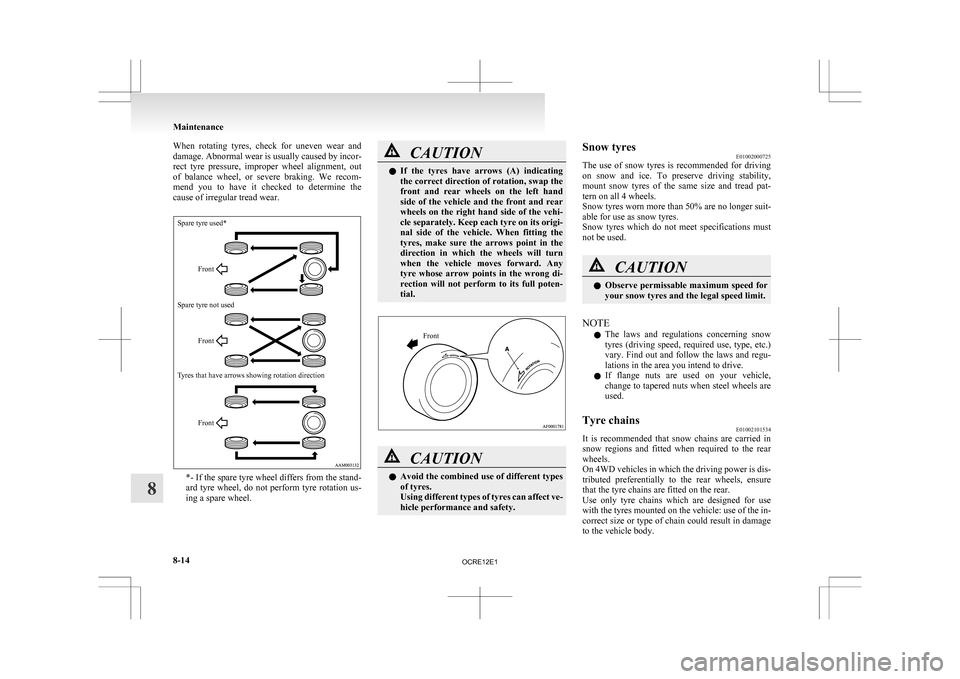
When rotating tyres, check for uneven wear and
damage.
Abnormal wear is usually caused by incor-
rect tyre pressure, improper wheel alignment, out
of balance wheel, or severe braking. We recom-
mend you to have it checked to determine the
cause of irregular tread wear.
Spare tyre used*
Spare tyre not used Front
Front
Front
Tyres that have arrows showing rotation direction *- If the spare tyre wheel differs from the stand-
ard
tyre wheel, do not perform tyre rotation us-
ing a spare wheel. CAUTION
l
If
the tyres have arrows (A) indicating
the correct direction of rotation, swap the
front and rear wheels on the left hand
side of the vehicle and the front and rear
wheels on the right hand side of the vehi-
cle separately. Keep each tyre on its origi-
nal side of the vehicle. When fitting the
tyres, make sure the arrows point in the
direction in which the wheels will turn
when the vehicle moves forward. Any
tyre whose arrow points in the wrong di-
rection will not perform to its full poten-
tial.
Front CAUTION
l
Avoid
the combined use of different types
of tyres.
Using different types of tyres can affect ve-
hicle performance and safety. Snow tyres
E01002000725
The
use of snow tyres is recommended for driving
on snow and ice. To preserve driving stability,
mount snow tyres of the same size and tread pat-
tern on all 4 wheels.
Snow tyres worn more than 50% are no longer suit-
able for use as snow tyres.
Snow tyres which do not meet specifications must
not be used. CAUTION
l
Observe
permissable maximum speed for
your snow tyres and the legal speed limit.
NOTE l The
laws and regulations concerning snow
tyres (driving speed, required use, type, etc.)
vary. Find out and follow the laws and regu-
lations in the area you intend to drive.
l If flange nuts are used on your vehicle,
change to tapered nuts when steel wheels are
used.
Tyre chains E01002101534
It is recommended that snow chains are carried in
snow
regions and fitted when required to the rear
wheels.
On 4WD vehicles in which the driving power is dis-
tributed preferentially to the rear wheels, ensure
that the tyre chains are fitted on the rear.
Use only tyre chains which are designed for use
with the tyres mounted on the vehicle: use of the in-
correct size or type of chain could result in damage
to the vehicle body. Maintenance
8-14
8
OCRE12E1
Page 312 of 369
![MITSUBISHI L200 2010 4.G Owners Manual Before fitting tyre chains, we recommend you to
consult
a MITSUBISHI MOTORS Authorized Serv-
ice Point. The max. chain height is as follows. Tyre size Wheel size Max. chain
height [mm] 195R15C MITSUBISHI L200 2010 4.G Owners Manual Before fitting tyre chains, we recommend you to
consult
a MITSUBISHI MOTORS Authorized Serv-
ice Point. The max. chain height is as follows. Tyre size Wheel size Max. chain
height [mm] 195R15C](/img/19/7568/w960_7568-311.png)
Before fitting tyre chains, we recommend you to
consult
a MITSUBISHI MOTORS Authorized Serv-
ice Point. The max. chain height is as follows. Tyre size Wheel size Max. chain
height [mm] 195R15C,
215/70R15C *
15x6.0 JJ
22205R16C 16x6.0 JJ
205/80R16 16x6.0 JJ
245/70R16 16x7.0 J
245/65R17 17x7.5 J
* :
215/70R15C size should only be used as snow
tyres. The speed limit for tyre chain is 50 km/h (30
mph)
and remove the tyre chains as soon as possible on
snow free roads. WARNING
l DO
NOT use a jack when fitting the
chains, as in thsee conditions, the tyres
may slip on the icy road causing the vehi-
cle to slip off the jack. CAUTION
l
Practice
fitting the chains before you
need them.
Don’t expect help from other people in
the cold.
l Choose a clear straight stretch of road
where you can pull over and still be seen
while you are fitting the chains. CAUTION
l
Do
not fit chains before you need them.
This will wear out your tyres and the
road surface.
l After driving around 100-300 metres,
stop and retighten the chains.
l Drive carefully and do not exceed
50 km/h (30 mph). Remember, fitting
chains is not going to stop accidents from
happening.
l When tyre chains are installed, take care
that they do not damage the disc wheel or
body.
l An aluminium wheel can be damaged by
a tyre chain while driving. When fitting a
tyre chain on an aluminium wheel, take
care that any part of the chain and fitting
cannot be brought into contact with the
wheel.
l When installing or removing the tyre
chains, take care that hands and other
parts of your body are not injured by the
sharp edges of the vehicle body.
l Install the chains only on the rear tyres
and tighten them as tightly as possible
with the ends securely fastened.
NOTE l The
laws and regulations concerning the use
of tyre chains vary. Find out and follow the
laws and regulations of the area you're driv-
ing in.
In most countries, it is prohibited by law to
use tyre chains on roads without snow. Clutch pedal free play*
E01002200222
Press
down the clutch pedal with your fingers until
initial resistance is felt.
This distance should be within the specified range. A- Free play: 3 to 8 mm
If
the clutch pedal free play is not within the stand-
ard range, we recommend you to have it checked. Maintenance
8-15 8
OCRE12E1
Page 313 of 369
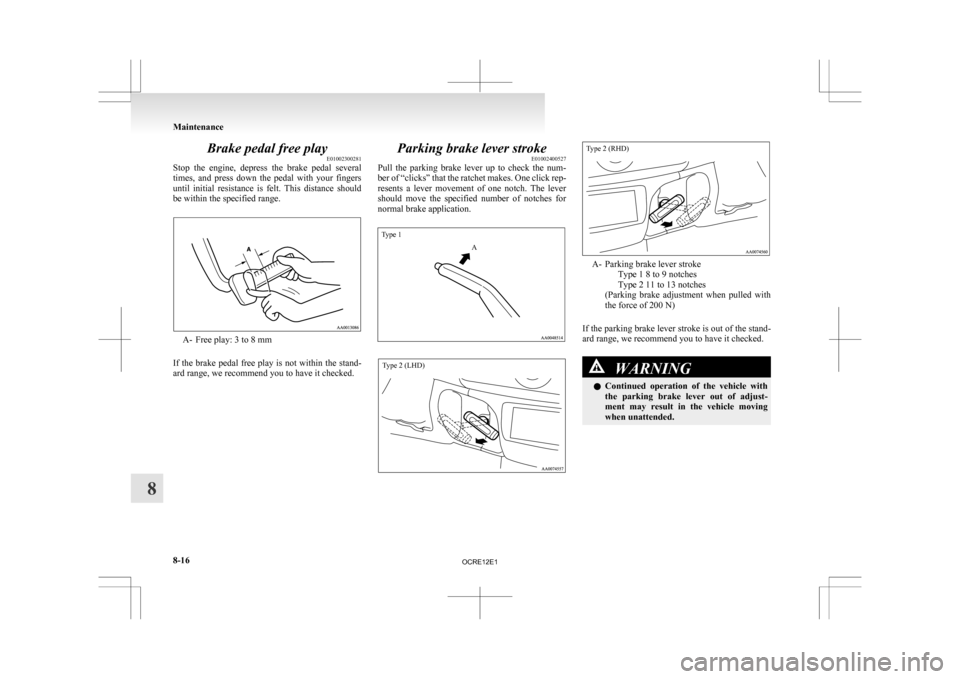
Brake pedal free play
E01002300281
Stop
the engine, depress the brake pedal several
times, and press down the pedal with your fingers
until initial resistance is felt. This distance should
be within the specified range. A- Free play: 3 to 8 mm
If
the brake pedal free play is not within the stand-
ard range, we recommend you to have it checked. Parking brake lever stroke
E01002400527
Pull
the parking brake lever up to check the num-
ber of “clicks” that the ratchet makes. One click rep-
resents a lever movement of one notch. The lever
should move the specified number of notches for
normal brake application.
Type 1
A
Type 2 (LHD)
Type 2 (RHD) A- Parking brake lever stroke
Type 1 8 to 9 notches
Type 2 11 to 13 notches
(Parking
brake adjustment when pulled with
the force of 200 N)
If the parking brake lever stroke is out of the stand-
ard range, we recommend you to have it checked. WARNING
l Continued
operation of the vehicle with
the parking brake lever out of adjust-
ment may result in the vehicle moving
when unattended. Maintenance
8-16
8
OCRE12E1
Page 314 of 369
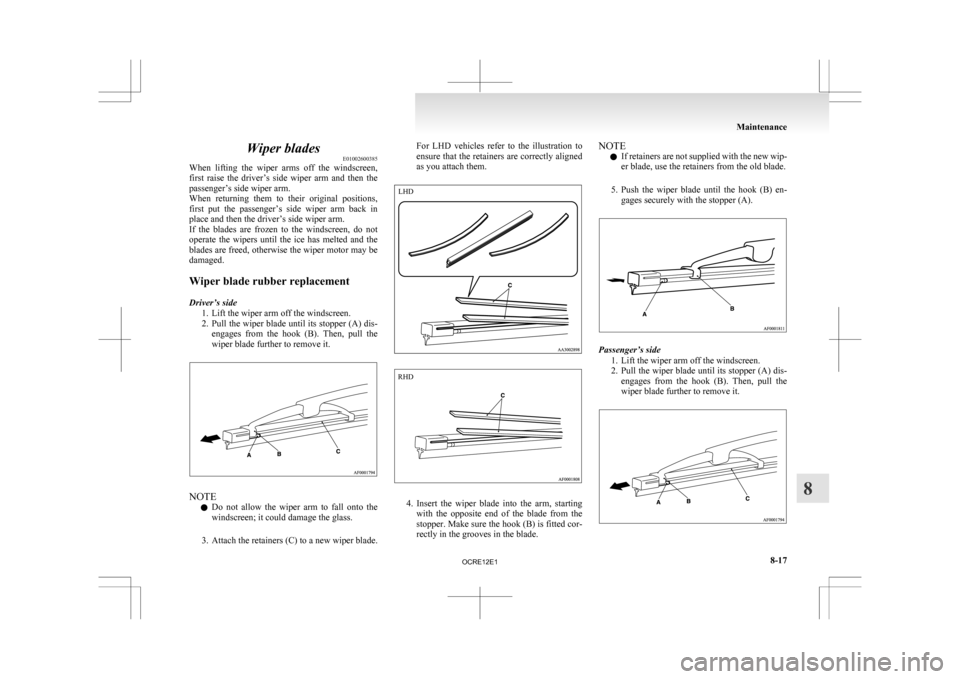
Wiper blades
E01002600385
When
lifting the wiper arms off the windscreen,
first raise the driver’s side wiper arm and then the
passenger’s side wiper arm.
When returning them to their original positions,
first put the passenger’s side wiper arm back in
place and then the driver’s side wiper arm.
If the blades are frozen to the windscreen, do not
operate the wipers until the ice has melted and the
blades are freed, otherwise the wiper motor may be
damaged.
Wiper blade rubber replacement
Driver’s side
1. Lift the wiper arm off the windscreen.
2. Pull the wiper blade until its stopper (A) dis-engages from the hook (B). Then, pull the
wiper blade further to remove it. NOTE
l Do
not allow the wiper arm to fall onto the
windscreen; it could damage the glass.
3. Attach the retainers (C) to a new wiper blade. For LHD vehicles refer to the illustration to
ensure
that the retainers are correctly aligned
as you attach them.
LHD
RHD 4. Insert
the wiper blade into the arm, starting
with the opposite end of the blade from the
stopper. Make sure the hook (B) is fitted cor-
rectly in the grooves in the blade. NOTE
l If
retainers are not supplied with the new wip-
er blade, use the retainers from the old blade.
5. Push the wiper blade until the hook (B) en- gages securely with the stopper (A). Passenger’s side
1.
Lift the wiper arm off the windscreen.
2. Pull the wiper blade until its stopper (A) dis- engages from the hook (B). Then, pull the
wiper blade further to remove it. Maintenance
8-17 8
OCRE12E1
Page 315 of 369
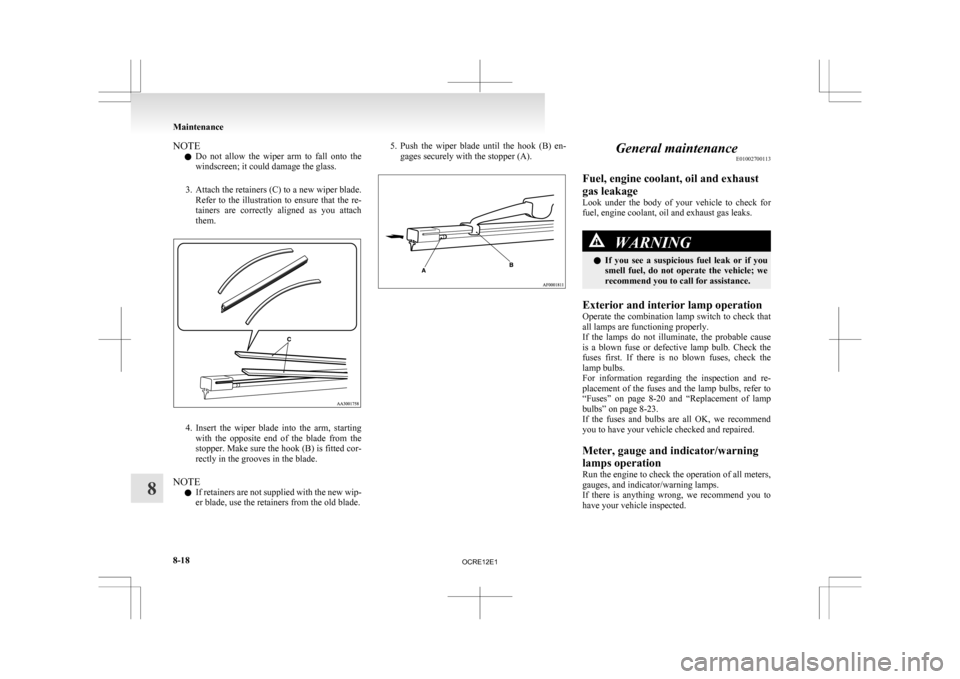
NOTE
l Do
not allow the wiper arm to fall onto the
windscreen; it could damage the glass.
3. Attach the retainers (C) to a new wiper blade. Refer to the illustration to ensure that the re-
tainers are correctly aligned as you attach
them. 4. Insert
the wiper blade into the arm, starting
with the opposite end of the blade from the
stopper. Make sure the hook (B) is fitted cor-
rectly in the grooves in the blade.
NOTE l If retainers are not supplied with the new wip-
er blade, use the retainers from the old blade. 5. Push
the wiper blade until the hook (B) en-
gages securely with the stopper (A). General maintenance
E01002700113
Fuel, engine coolant, oil and exhaust
gas leakage
Look
under the body of your vehicle to check for
fuel, engine coolant, oil and exhaust gas leaks. WARNING
l If
you see a suspicious fuel leak or if you
smell fuel, do not operate the vehicle; we
recommend you to call for assistance.
Exterior and interior lamp operation
Operate
the combination lamp switch to check that
all lamps are functioning properly.
If the lamps do not illuminate, the probable cause
is a blown fuse or defective lamp bulb. Check the
fuses first. If there is no blown fuses, check the
lamp bulbs.
For information regarding the inspection and re-
placement of the fuses and the lamp bulbs, refer to
“Fuses” on page 8-20 and “Replacement of lamp
bulbs” on page 8-23.
If the fuses and bulbs are all OK, we recommend
you to have your vehicle checked and repaired.
Meter, gauge and indicator/warning
lamps operation
Run the engine to check the operation of all meters,
gauges, and indicator/warning lamps.
If there is anything wrong, we recommend you to
have your vehicle inspected. Maintenance
8-18
8
OCRE12E1
Page 316 of 369
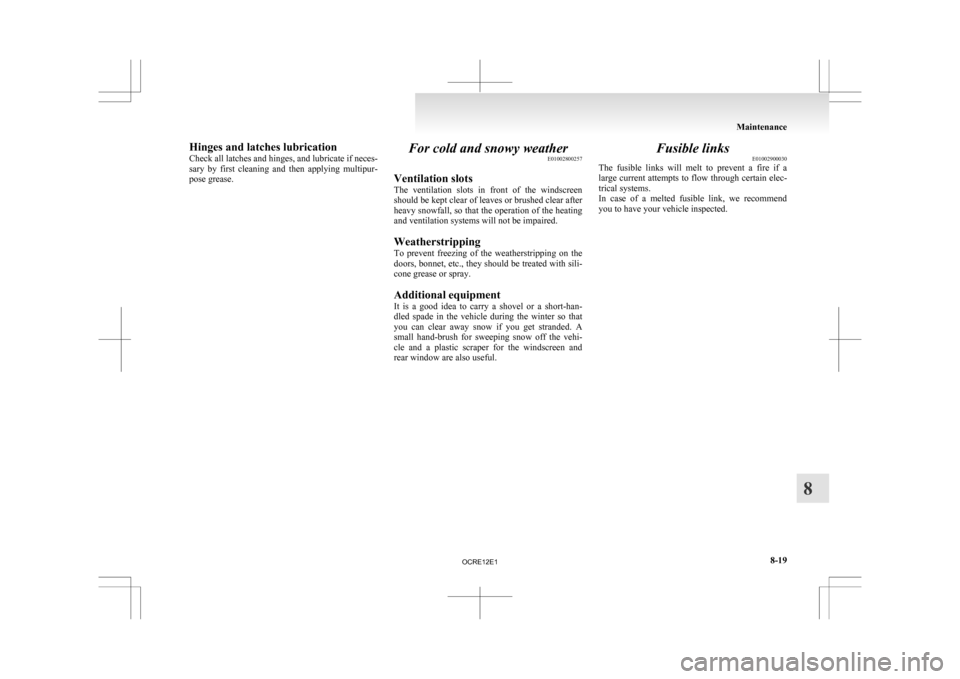
Hinges and latches lubrication
Check
all latches and hinges, and lubricate if neces-
sary by first cleaning and then applying multipur-
pose grease. For cold and snowy weather
E01002800257
Ventilation slots
The
ventilation slots in front of the windscreen
should be kept clear of leaves or brushed clear after
heavy snowfall, so that the operation of the heating
and ventilation systems will not be impaired.
Weatherstripping
To prevent freezing of the weatherstripping on the
doors, bonnet, etc., they should be treated with sili-
cone grease or spray.
Additional equipment
It is a good idea to carry a shovel or a short-han-
dled spade in the vehicle during the winter so that
you can clear away snow if you get stranded. A
small hand-brush for sweeping snow off the vehi-
cle and a plastic scraper for the windscreen and
rear window are also useful. Fusible links
E01002900030
The
fusible links will melt to prevent a fire if a
large current attempts to flow through certain elec-
trical systems.
In case of a melted fusible link, we recommend
you to have your vehicle inspected. Maintenance
8-19 8
OCRE12E1
Page 317 of 369
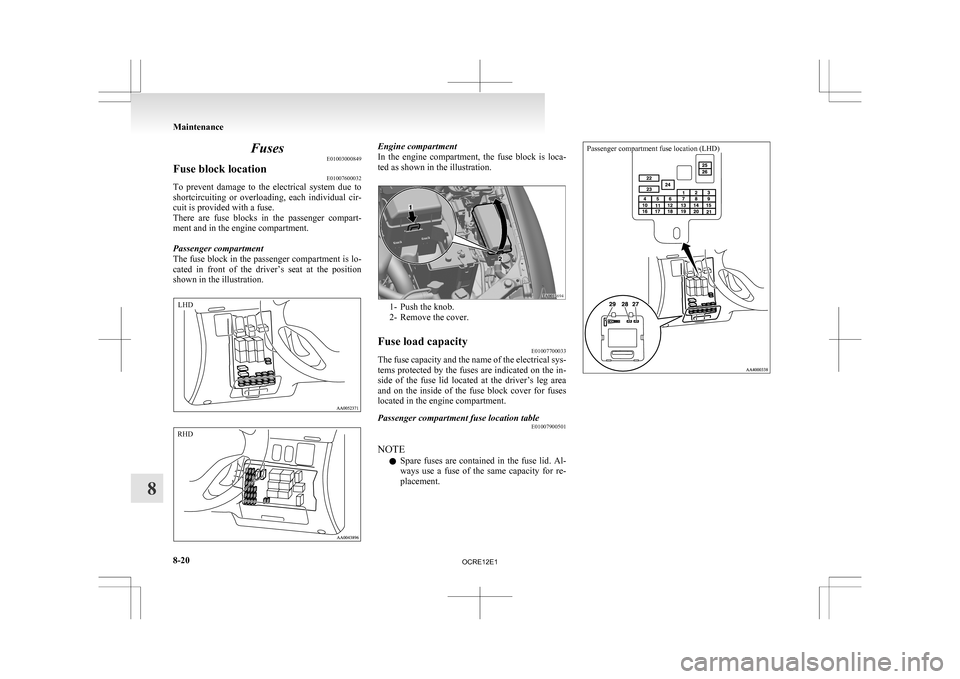
Fuses
E01003000849
Fuse block location E01007600032
To prevent damage to the electrical system due to
shortcircuiting
or overloading, each individual cir-
cuit is provided with a fuse.
There are fuse blocks in the passenger compart-
ment and in the engine compartment.
Passenger compartment
The fuse block in the passenger compartment is lo-
cated in front of the driver’s seat at the position
shown in the illustration. Engine compartment
In
the engine compartment, the fuse block is loca-
ted as shown in the illustration. 1- Push the knob.
2-
Remove the cover.
Fuse load capacity E01007700033
The fuse capacity and the name of the electrical sys-
tems
protected by the fuses are indicated on the in-
side of the fuse lid located at the driver’s leg area
and on the inside of the fuse block cover for fuses
located in the engine compartment.
Passenger compartment fuse location table E01007900501
NOTE l Spare
fuses are contained in the fuse lid. Al-
ways use a fuse of the same capacity for re-
placement.
Passenger compartment fuse location (LHD) Maintenance
8-20
8LHD RHD
OCRE12E1
Page 318 of 369
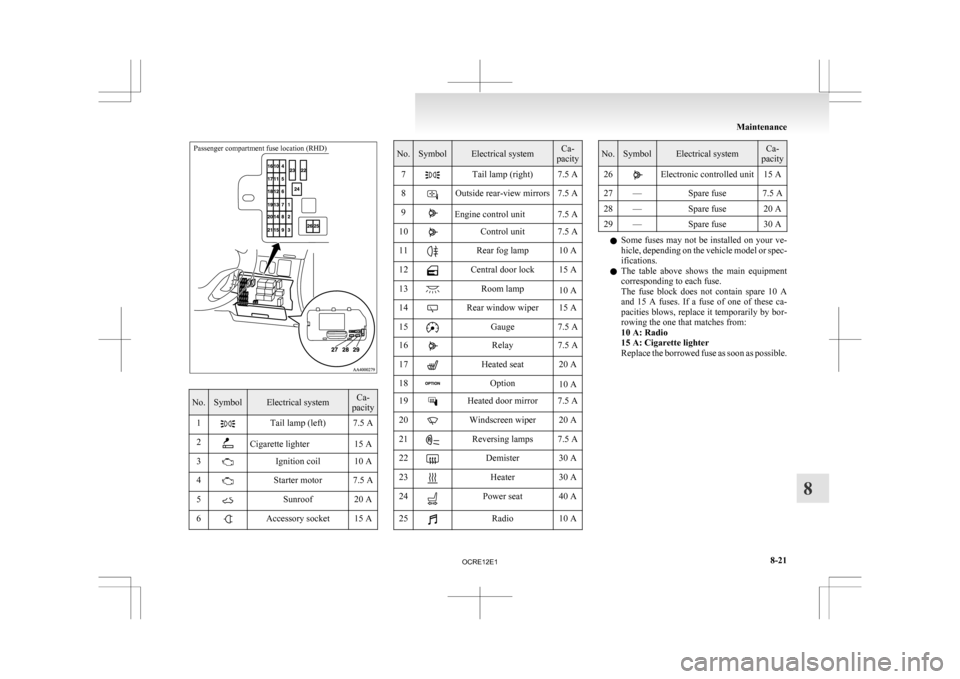
Passenger compartment fuse location (RHD)No. Symbol Electrical system Ca-
pacity
1 Tail lamp (left) 7.5 A
2 Cigarette lighter 15 A
3 Ignition coil 10 A
4 Starter motor 7.5 A
5 Sunroof 20 A
6 Accessory socket 15 A No. Symbol Electrical system Ca-
pacity
7 Tail lamp (right) 7.5 A
8 Outside rear-view mirrors 7.5 A
9 Engine control unit 7.5 A
10 Control unit 7.5 A
11 Rear fog lamp 10 A
12 Central door lock 15 A
13 Room lamp
10 A
14 Rear window wiper 15 A
15 Gauge 7.5 A
16 Relay 7.5 A
17 Heated seat 20 A
18 Option
10 A
19 Heated door mirror 7.5 A
20 Windscreen wiper 20 A
21 Reversing lamps 7.5 A
22 Demister 30 A
23 Heater 30 A
24 Power seat 40 A
25 Radio 10 A No. Symbol Electrical system Ca-
pacity
26 Electronic controlled unit 15 A
27 — Spare fuse 7.5 A
28 — Spare fuse 20 A
29 — Spare fuse 30 A l
Some
fuses may not be installed on your ve-
hicle, depending on the vehicle model or spec-
ifications.
l The table above shows the main equipment
corresponding to each fuse.
The fuse block does not contain spare 10 A
and 15 A fuses. If a fuse of one of these ca-
pacities blows, replace it temporarily by bor-
rowing the one that matches from:
10 A: Radio
15 A: Cigarette lighter
Replace the borrowed fuse as soon as possible. Maintenance
8-21 8
OCRE12E1
Page 319 of 369
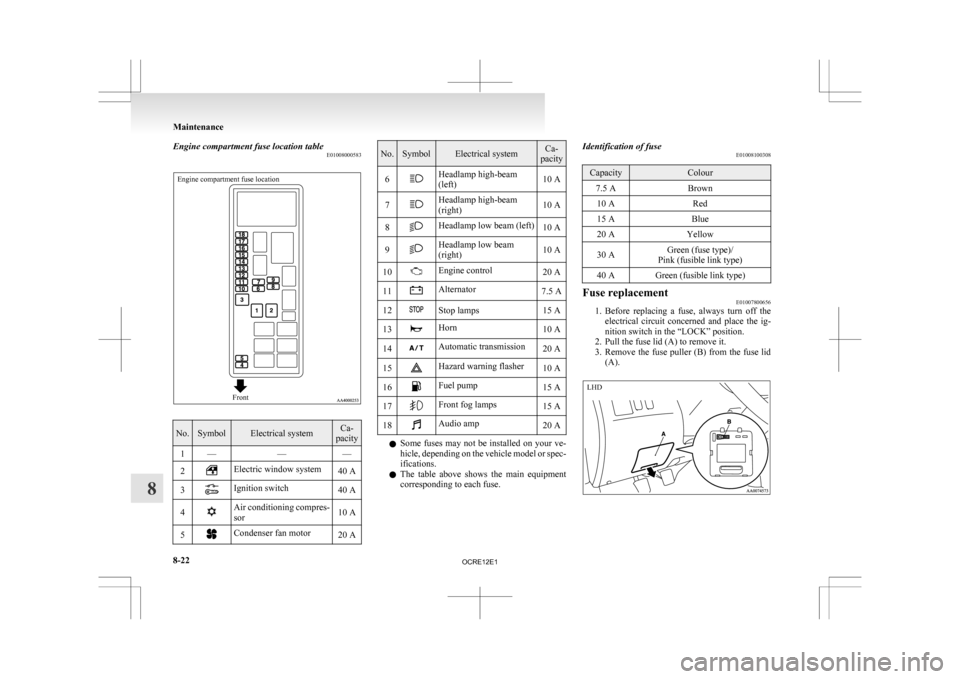
Engine compartment fuse location table
E01008000583Engine compartment fuse location
FrontNo. Symbol Electrical system Ca-
pacity
1 — ——
2 Electric window system
40 A
3 Ignition switch
40 A
4 Air conditioning compres-
sor
10 A
5 Condenser fan motor
20 A No. Symbol Electrical system Ca-
pacity
6 Headlamp high-beam
(left)
10 A
7 Headlamp high-beam
(right)
10 A
8 Headlamp low beam (left)
10 A
9 Headlamp low beam
(right)
10 A
10 Engine control
20 A
11 Alternator
7.5 A
12 Stop lamps
15 A
13 Horn
10 A
14 Automatic transmission
20 A
15 Hazard warning flasher
10 A
16 Fuel pump
15 A
17 Front fog lamps
15 A
18 Audio amp
20 A l
Some
fuses may not be installed on your ve-
hicle, depending on the vehicle model or spec-
ifications.
l The table above shows the main equipment
corresponding to each fuse. Identification of fuse
E01008100308 Capacity Colour
7.5 A Brown
10 A Red
15 A Blue
20 A Yellow
30 A Green (fuse type)/
Pink (fusible link type)
40 A Green (fusible link type) Fuse replacement
E01007800656
1. Before
replacing a fuse, always turn off the
electrical circuit concerned and place the ig-
nition switch in the “LOCK” position.
2. Pull the fuse lid (A) to remove it.
3. Remove the fuse puller (B) from the fuse lid (A). Maintenance
8-22
8 LHD
OCRE12E1
Page 320 of 369
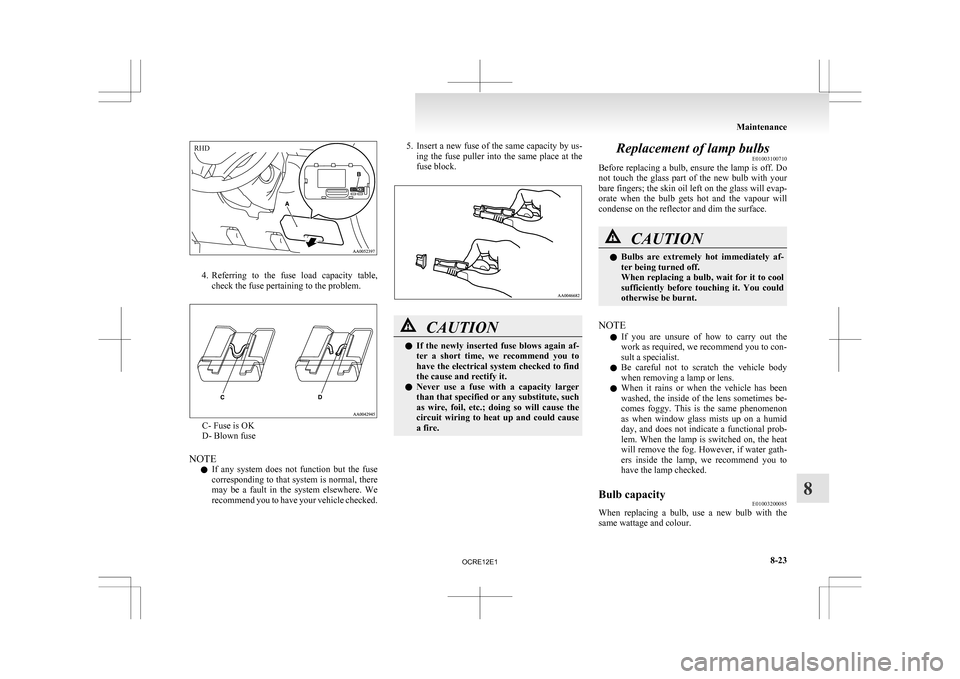
4. Referring
to the fuse load capacity table,
check the fuse pertaining to the problem. C- Fuse is OK
D- Blown fuse
NOTE l If
any system does not function but the fuse
corresponding to that system is normal, there
may be a fault in the system elsewhere. We
recommend you to have your vehicle checked. 5. Insert
a new fuse of the same capacity by us-
ing the fuse puller into the same place at the
fuse block. CAUTION
l
If
the newly inserted fuse blows again af-
ter a short time, we recommend you to
have the electrical system checked to find
the cause and rectify it.
l Never use a fuse with a capacity larger
than that specified or any substitute, such
as wire, foil, etc.; doing so will cause the
circuit wiring to heat up and could cause
a fire. Replacement of lamp bulbs
E01003100710
Before
replacing a bulb, ensure the lamp is off. Do
not touch the glass part of the new bulb with your
bare fingers; the skin oil left on the glass will evap-
orate when the bulb gets hot and the vapour will
condense on the reflector and dim the surface. CAUTION
l
Bulbs
are extremely hot immediately af-
ter being turned off.
When replacing a bulb, wait for it to cool
sufficiently before touching it. You could
otherwise be burnt.
NOTE l If
you are unsure of how to carry out the
work as required, we recommend you to con-
sult a specialist.
l Be careful not to scratch the vehicle body
when removing a lamp or lens.
l When it rains or when the vehicle has been
washed, the inside of the lens sometimes be-
comes foggy. This is the same phenomenon
as when window glass mists up on a humid
day, and does not indicate a functional prob-
lem. When the lamp is switched on, the heat
will remove the fog. However, if water gath-
ers inside the lamp, we recommend you to
have the lamp checked.
Bulb capacity E01003200085
When replacing a bulb, use a new bulb with the
same wattage and colour. Maintenance
8-23 8RHD
OCRE12E1